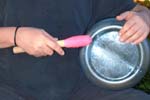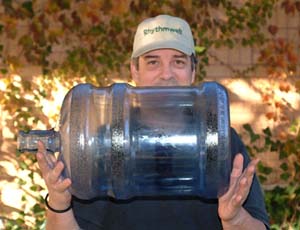Water Bottles
Rhythmweb
homemade percussion home
 We
call polycarbonate resin containers "Moondrums" because
they're the first drum light enough to be carried into space...the
underrated sound source of the 21st century. We
call polycarbonate resin containers "Moondrums" because
they're the first drum light enough to be carried into space...the
underrated sound source of the 21st century.
We began using and experimenting with them in 1994. They have
served us well, lightweight and reliable tools, whether with a batch
of kids in a school or community center somewhere, in the streets
of Downtown Dallas and Fort Worth, or in a recording studio somewhere.
When played with the hands, they take on a dreamlike, reflective
quality, and played with one wrapped stick or mallet and one hand
they are useful in drum circle situations, where a loud instrument
is a must...
Choosing the right ones - The various makes and
brands have many subtle variations in shape and sound. Some have
sharper rims, and some have very rounded rims; many have textures
that are good for scratching, or flat panels that give a lower bassy
pitch (like the one on the right in the picture). It's good to develop
an eye for noticing the water bottles and other hollow shapes in
various stores and venues, and make it a point to collect any interesting
shapes that you don't already have.. If you are a true sound aficionado,
they all come in handy sooner or later.
When choosing water bottles for instruments, test
all the pitches by playing with a flat hand on the bottom;
some will be lower than most and some higher, with many almost alike
in the middle.. Don't mind all those regular customers, acting as
if you are ready for the funny white coat with the really long sleeves
;-). You are on a mission.
You will want to obtain pitches that relate well to each other,
an interval of a step apart, or a third or fourth. The higher pitches
seem to be more rare..
Playing methods:
 One
Hand and One Mallet - One advantage to this style of playing
water bottles is that you get plenty of volume and projection. One
Hand and One Mallet - One advantage to this style of playing
water bottles is that you get plenty of volume and projection.
There is a low note in the sweet spot (halfway from center
to rim). Image forthcoming.
There are six basic tones available from the rim. They
are: wide open(on the seam and non), with the thumb or finger
pressed lightly in the center, (on the seam and non), and then
a note with the other hand fully muffling the center of the head,
(again, on the seam and non).
here are
the sounds of the six rim tones.
Each pair is played twice before moving on to the next.
More will be offered on the rim tones very soon.
FOR NEWBIES: The rhythm 'NUBI'
Let's start by getting comfortable with using the low note. All
the main notes will be made with the right hand (left if you're
left handed)The other hand will muffle the head lightly to make
the closed notes. Play lightly from the edge and move in slowly.
At one point close to midway between the center and the edge, the
tone will open up and sound very round and warm. that is the sweet
spot. (an image will be up soon.)
Experiment with holding the bottle
more or less tightly too, because this makes a big difference
in the sound. If you hold the bottle as lightly as possible, the
bottle will almost seem to breathe, and the tone will be very open..
For now, no rim tones are used. An o is
an open note, and the x is
the closed note. The t is
a light touch with the left hand to stop the drum from ringing.
A and B:
Listen [A]
R |
L |
R |
R |
. |
R |
R |
. |
R |
R |
. |
R |
o |
t |
x |
x |
. |
x |
x |
. |
o |
o |
. |
o |
1 |
. |
. |
2 |
. |
. |
3 |
. |
. |
4 |
. |
. |
Listen [B]
R |
L |
R |
R |
. |
R |
R |
L |
R |
R |
. |
R |
o |
t |
x |
x |
. |
o |
o |
t |
x |
x |
. |
o |
1 |
. |
. |
2 |
. |
. |
3 |
. |
. |
4 |
. |
. |
Now, having mastered these two, you are ready for the first part
of the rhythm "Nubi". It consists here of a roll [rumble] at beginning
and end, with this rhythm in the middle:
A twice, B once, and A once
again, to form AABA | LISTEN
to NUBI bottle part 1
This ordering of very simple rhythms into different forms is one
of the secrets to getting an effortless groove. Suddenly, although
the individual rhythms are only four beats long, you are playing
a loop that is 16 beats long (four 'bars' of 4), giving more order
to the scheme of things. its like looking to the horizon instead
of the next vehicle: a bigger viewpoint, the big picture. Then
you can alternate these with other 4 and 8 bar sections, and so
on. [A series for teachers is forthcoming. Stay tuned.]
We have played the rhythm approximately 4 times
through in this example; notice that during the second half,
we played the LEFT HAND TOUCH more loudly, so you can hear the
left hand stroke. Both ways are valid and usefu. You can then vary
the tones to include the rim tones. Here is an
example of that type of thing.
Using only what we have learned so far, it is possible
to construct useful polyrhythms for water bottle ensembles. When
you add claves, coffee
can drums, and Wambano
agogos, you have a very colorful
range of sounds for a low price.
Two Hands - This type of playing is great for
solo or living room playing and for recording, when high volume
and projection are not required. one can achieve a great many useful
tones, including scratching and rubbing sounds. Virtually every
part of the bottle is useful for something. The low note is fattest
when played by the hand. Nothing beats that wide mallet..The techiniques
vary widely according to whether you play with the bottle between
your knees conga style or over your lap doumbek style.
 At
left is a third style, the 'floating' style, holding the bottle
from only the nodal points, to maximize resonance. The player
is free to turn the bottle or throw it into the air and catch
on the beat and so on. a little water in
the bottle livens things up pitchwise sometimes. What is interesting
when recording in this style is how much difference mike placement
makes to the sound. to demonstrate this, I have played without
varying the rhythm, while moving the bottle, four bars with the
microphone closest to the bottom, four with it in the middle,
and four with the spout pointing closely at the microphone. i
did it twice, SLIGHTLY varying placement, to give you an idea
of the range of sound available recording in this style. No effects
are used on any of this. At
left is a third style, the 'floating' style, holding the bottle
from only the nodal points, to maximize resonance. The player
is free to turn the bottle or throw it into the air and catch
on the beat and so on. a little water in
the bottle livens things up pitchwise sometimes. What is interesting
when recording in this style is how much difference mike placement
makes to the sound. to demonstrate this, I have played without
varying the rhythm, while moving the bottle, four bars with the
microphone closest to the bottom, four with it in the middle,
and four with the spout pointing closely at the microphone. i
did it twice, SLIGHTLY varying placement, to give you an idea
of the range of sound available recording in this style. No effects
are used on any of this.
example in
5 | example in 6
A beautifully resonant bass gong is possible by cutting the top
off at the right spot in the shoulder. we will post on that when
we have time.
|

